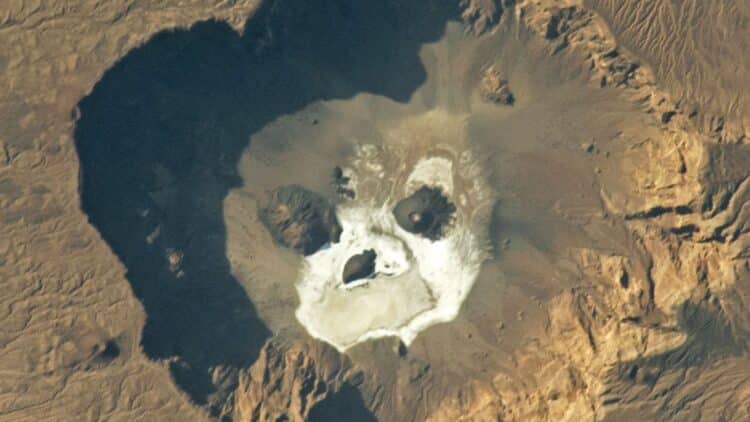Just imagine the scene: you’re on the International Space Station, flying over the Sahara Desert, when you come across something completely out of the ordinary: a gigantic, all-white geological formation that looks like a giant skull staring into space. Something like a science fiction movie? Or maybe even a horror movie? Well… this isn’t a montage. This structure is located in northern Chad and has a name: Trou au Natron. It’s a very rare, completely isolated volcanic caldera that was recorded in February 2023 by an astronaut using a Nikon D5 camera.
The skull-shaped illusion
We know what you might be thinking, but no, the skull-like appearance is not a coincidence or a montage. In fact, the shape of the Trou au Natron, when viewed from above, actually resembles a skeletal face with eyes, a nose, and a mouth. This is due to a unique visual combination, which will make more sense when given more details:
- The “eye sockets” and “nose” are volcanic cinder cones that formed from ancient eruptions.
- The ghostly white coloring of the mouth and cheeks comes from a crust of salts called natron, a natural mixture of sodium carbonate, bicarbonate, chloride and sulfate.
- The shadows cast by the rims of the caldera form contours that reinforce the resemblance to a skull.
Well, it’s not every day that we come across a formation like this. This type of crater only appears after colossal eruptions or when magma chambers collapse. In the case of Trou au Natron, we’re talking about a huge hole about 1,000 meters deep and up to 8 km wide, high up in Tibesti, the highest part of the Sahara Desert.
A desert mystery: What lies beneath Trou au Natron
Despite its frightening appearance, Trou au Natron is more than just a visual phenomenon (much more than just that shiny white skull). This is because it is a geological structure that is still little understood. After all, as it is located in one of the most remote and politically unstable regions on the planet, its study is made difficult by both geography and security.
Of course, scientists already know that the volcano is extinct, but they still don’t know exactly when it last erupted. In fact, here’s a fun fact: geological analyses indicate that around 14,000 years ago, this caldera was filled with a deep glacial lake, possibly the result of a wetter climate or glaciers that melted after the last ice age. In other words, we haven’t found a literal skull, but rather a visual echo of a landscape that was once completely different. Even though it’s hard to even imagine, Trou au Natron, which today seems barren, was a vibrant ecosystem in ancient times.
This discovery is much more than just a white skull
What happened was that, over the millennia, climate change radically transformed the region. The lake evaporated, the winds carried away the moisture, and the intense heat of the Sahara took over. So what was left was a thick deposit of alkaline salts, which formed the white crust visible from space. And these salts, in addition to reinforcing the contrast with the dark soil around it, prevent the proliferation of life, creating an environment hostile even to microorganisms.
Not only that, the Tibesti Mountains are home to resilient wildlife, including golden jackals, desert foxes, gazelles and birds adapted to water scarcity; as well as being the ancestral home of the Toubou people, who, yes, still inhabit parts of the region in a semi-nomadic manner. And what’s more, it reminds us that what seems dead today may once have been a place full of movement, water and life. An example of this are the polar dinosaurs discovered in Antarctica, which have been there for 120 million years.


